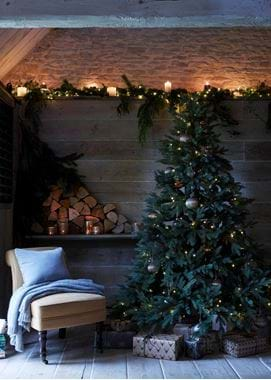The reason for the tree
The reason for the tree
Perhaps the truest Christmas emblem of them all, the Christmas tree is something that most of us invite into our homes every December (even earlier for some), but the reasons why have been lost along the way. Unsurprisingly, it has Christian and pagan origins, like many of Christmas’ traditions, that can be traced back thousands of years...
Tall, short, bushy or a little more bare – whatever shape or size your Christmas tree, decorating its branches is probably one of the festive activities we look forward to most. When it stands proud, be it in your hallway, sitting room or dining room, it certainly feels as though Christmas is just around the corner. The fir tree has long had celebratory connotations throughout December. Pagans used fir branches in their homes during the winter solstice (or midwinter as it’s also known). They believed that the sun was a god and that winter came each year when the sun god fell ill, and so celebrated the solstice because it meant the worst of winter was over and spring was drawing closer. Evergreen boughs reminded them of all the green plants that spring would bring. They were a sign of health and renewal. Similarly, the Romans used fir trees to fill their temples for the festival of Saturnalia (the celebration of the god of agriculture, Saturn) from 17th–23rd December, to recognise that farms and orchards would soon be fruitful again following the solstice. While many Christians viewed evergreens as a sign of eternal life, which felt particularly pertinent ‘in the bleak midwinter’.
When the fir tree began to tiptoe into Christmas territory though, remains a little unclear. There are lots of legends about various historical figures, from the preacher Martin Luther to St Boniface of Crediton, who lay claim to be the original Christmas tree founders. There’s little evidence to support them, although many do credit Luther for being the first to put lights on the Christmas tree after he was struck by the beautiful starlight he saw when writing a sermon amidst an evergreen wood one winter’s evening. The Renaissance is when the first clear records of evergreen trees being used as symbols of Christmas were found though, with Estonia (in 1441), Latvia (later, in 1510) and Strasbourg (in 1521) being the earliest adopters – although the cities of Tallinn and Riga still dispute who was actually responsible for the first-ever Christmas tree. It’s generally believed that medieval plays are what rooted the fir tree in Christmas traditions. Typically, they depicted the nativity and linked to the story of creation, because Christmas Eve was also once considered Adam and Eve’s ‘feast day’, and these biblical plays would show paradise trees (representing the Garden of Eden) adorned with fruit. Such plays were largely banned in the 16th century, and so people would instead bring their own versions of paradise trees into their homes. They’d be decorated with round pastry wafers that symbolised the Eucharist, which later evolved into edible decorations first used in Germany and which are still used today on Christmas trees around the world.
Christmas trees weren’t necessarily always in fir form however. In many parts of northern Europe, people would use cherry or hawthorn plants – or even just a branch – in the hope they’d flower at Christmastime. And if you couldn’t afford a real plant, many would make wooden pyramids that they’d decorate with paper, fruit and candles.
Fast-forward to the 1800s, and the Christmas tree tradition really began to accelerate thanks to the British monarchy. By this point, Christmas trees were a festive custom in Germany and Holland. Gladly, they brought the tradition over to Britain where Queen Victoria and her husband, Prince Albert, decided to erect a majestic tree for their children at Windsor Castle in 1841, with presents hung from the tree itself. Later, in 1846, the royals were sketched in the Illustrated London News, stood, with their children, around their Christmas tree. Queen Victoria was very popular with her subjects, and whatever she did at court almost immediately became the ‘done thing’. And so, the Christmas tree shot to stardom across Britain. In America, the queen had less influence, and instead, it was the image of a happy family, gathered and exchanging gifts around a beautiful tree, that appealed most as it was a far more pleasing alternative to the rowdier, alcohol-fuelled one that had previously dominated. And so, the Christmas tree was propelled even further, helped along by the illustration in Clement Moore’s poem ’Twas the night before Christmas. An illustration that proved to be incredibly powerful as it also helped to shape our modern-day image of red-cheeked and cheery St Nick.






